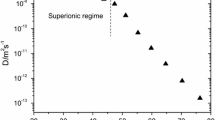Abstract
The results of a simulation of the behavior of vacancies and interstitial atoms in uranium-dioxide fuel at temperature corresponding to the conditions under which a fine-grain structure forms are presented. It is shown that the distribution of point defects near grain boundaries and near line dislocations can be strongly nonuniform with differing spatial distribution of vacancies and intersitial atoms. Such a distribution of point defects can explain the experimentally observed grain-size dependence for threshold burnup at which fuel reconstruction starts.
Similar content being viewed by others
REFERENCES
M. Kinoshita, E. Kolstad, Hj. Matzke, et al., “High burnup project. (II) Irradiation and examination to investigate rim-structured fuel,” in: Proceedings of the ANS Meeting on Light Water Reactor Fuel Performance, Park City, Utah, April 10–13, 2000, pp. 590–603.
D. Baron, J. Spino, and D. Papaioannou, “Rim formation and fission gas behavior some structure remarks,” in: Proceedings of the International Seminar on Gas Behavior in Water Reactor Fuels, Cadarache, France, Sept. 26–29, 2000.
Hj. Matzke and M. Kinoshita, “Polygonization and high burnup structure in nuclear fuels,” J.Nucl.Mater., 247, 108–115 (1997).
M. Mogensen, J. Pearce, and C. Walker, “Behavior of fission gas in the rim region of high burnup UO2 fuel pellets with particular reference to results from XRF investigation,” ibid., 264, 99–112 (1999).
M. Cunningham, M. Freshley, and D. Lanning, “Development and characteristics of the rim region in high burnup UO2 pellets,” ibid., 188, 19–27 (1992).
K. Une, K. Nogita, S. Kashibe, and M. Imamura, “Microstructure change and its influence on fission gas release in high burnup UO2 fuel,” ibid., pp. 65–72.
J. Noirot, L. Desgranges, and P. Marimbeau, “Contribution of the RIM to the overall fission gas release: what do isotopic analyses reveal,” in: Proceedings of the International Seminar on Gas Behavior in Water Reactor Fuels, Cadarache, France, Sept. 26–29, 2000.
K. Une, K. Nogita, Y. Suzava, et al., “Effect of the grain size and PCI restrain on the rim structure formation of UO2 fuels,” in: Proceedings of the ANS Meeting on Light Water Reactor Fuel Performance, Park City, Utah, April 10–13, 2000, pp. 615–625.
M. Kinoshita, T. Kameyama, S. Kitajima, and Hj. Matzke, “Temperature and fission rate effect on the rim structure formation in a UO2 fuel with burnup of 7.9% FIMA,” J.Nucl.Mater., 252, 71–78 (1998).
I. Ray, Hj. Matzke, H. Thiele, and M. Kinoshita, “An electron microscopy study of the RIM structure of a UO2 fuel with a high burnup of 7.9% FIMA, ibid., 245, 115–123 (1997).
K. Nogita and K. Une, “Irradiation induced recrystallization in high burnup UO2 fuel,” ibid., 226, 302–310 (1995).
K. Une, M. Hirai, K. Nogita, et al., “Rim structure formation and high burnup fuel behavior of large-grained UO2 fuels,” ibid., 278, 54–63 (2000).
F. Schimtz and J. Papin, “High burnup effects on fuel behavior under accident conditions: the tests CABRI and REP-Na,” ibid., 270, 55–64 (1999).
J. Spino, D. Baron, M. Corquerelle, and S. Stalios, “High burnup rim structure: evidences that xenon-depletion, pore formation and grain subdivision start at different local burnups,” ibid., 256, 189–196 (1998).
J. Spino and D. Papaioannou, “Lattice parameter changes associated with the rim-structure formation in high burnup UO2 fuels by micro x-ray diffraction,” ibid., 281, 146–162 (2000).
L. Thomas, C. Beyer, and L. Charlot, “Microstructural analysis of LWR spent fuels at high burnup,” ibid., 188, 80–89 (1992).
N. Nakae, A. Harada, T. Kirihara, and S. Nasu, “Irradiation induced lattice defects in UO2,” ibid., 71, 314–319 (1978).
N. Nakae, T. Kirihara, and S. Nasu, “Irradiation induced volume change in UO2,” ibid., 74, 1–9 (1978).
Hj. Matzke and T. Wiss, “Radiation damage in nuclear materials,” in: Annual Report of Institute for Transuranium Elements (2000), Review Report, pp. 30–42.
J. Rest and G. Hofman, “An alternative explanation for evidence that xenon depletion, pore formation, and grain subdivision begin at different local burnups,” J.Nucl Mater., 277, 231 (2000).
M. Kinoshita, “Towards the mathematical model in rim structure formation,” ibid., 80, 88–101 (1979).
J. Griesmeyer and N. Ghoniem, “The response of fission gas bubbles to the dynamic behavior of point defects,” ibid., 80, 88–101 (1979).
J. Hirt and I. Lothe, The Theory of Dislocations [Russian translation], Atomizdat, Moscow (1972).
D. Olander, Fundamental Aspects of Nuclear Power Fuel Elements, TID-26711-PI, US Technical Information Center, Springfield, VA (1976).
V. Chkuaseli and Hj. Matzke, “Modeling of microstructure transformation (rim effect) in high burnup LWR nuclear fuels. The physical aspects of the RIM effect in uranium dioxide,” Internal Report, Institute for Transuranium Elements, July, 1996.
J. Spino, K. Vennix, and M. Coquerelle, “Detailed characterization of the rim microstructure in PWR fuels in the burnup range 40–67 GW/tU,” J.Nucl.Mater., 231, 179 (1996).
D. Baron, B. Hermitte, and J. Piron, “Microstructure and fracture toughness characterization of irradiated PWR fuels in the burnup range 40–67 GW/tU,” in: Proceedings of the IAEA Technical Committee Meeting on Advances in Pellet Technology for Improved Performance at High Burnups, Tokyo, Japan, Oct. 29-Nov. 1, 1996.
Author information
Authors and Affiliations
Rights and permissions
About this article
Cite this article
Likhanskii, V.V., Sorokin, A.A. & Khoruzhii, O.V. Special Features of the Distribution of Point Defects Inside Uranium Dioxide Fuel Grains with the Formation of the Rim Layer. Atomic Energy 96, 102–110 (2004). https://doi.org/10.1023/B:ATEN.0000027877.38400.df
Issue Date:
DOI: https://doi.org/10.1023/B:ATEN.0000027877.38400.df




